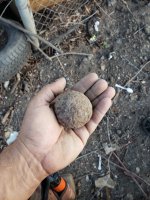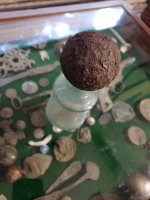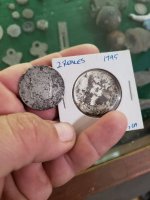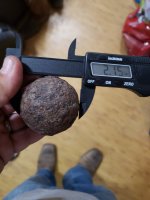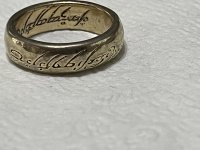You are using an out of date browser. It may not display this or other websites correctly.
You should upgrade or use an alternative browser.
You should upgrade or use an alternative browser.
🔎 UNIDENTIFIED Cannonball?
- Thread starter Nick79
- Start date
ARC
Gold Member
- Aug 19, 2014
- 37,248
- 131,546
- Detector(s) used
- JW 8X-ML X2-VP 585
- Primary Interest:
- All Treasure Hunting
Looks good from here... but only exact dimensions and exact weight will narrow it to one way or another.
Also a decent cleaning would help on any... IF any... details as to molding or sprue markings etc.
Repost these along with close up macro pics of anything out of norm / stands out /detail.
Also a decent cleaning would help on any... IF any... details as to molding or sprue markings etc.
Repost these along with close up macro pics of anything out of norm / stands out /detail.
Upvote
5
Nick79
Hero Member
- Jan 28, 2018
- 761
- 1,920
- 🏆 Honorable Mentions:
- 1
- Detector(s) used
- Equinox 800
- Primary Interest:
- Relic Hunting
- Thread starter
- #3
7.75" circumference, 1lb 7ozLooks good from here... but only exact dimensions and exact weight will narrow it to one way or another.
Also a decent cleaning would help on any... IF any... details as to molding or sprue markings etc.
Repost these along with close up macro pics of anything out of norm / stands out /detail.
Attachments
Upvote
2

TheCannonballGuy;2959497 said:You already know all (or most of) the following information... so it is mostly for other folks reading this post, because some of them don't already know it.
First and foremost:
ALL actual cannonballs were very carefully manufactured to be a "True-Sphere" ...meaning, as perfectly round as a glass marble, or a ball-bearing. Being out-of-round (even slightly egg-shaped, or with bumps, or a raised band, or a flat area) automatically disqualifies the "ball" from being a cannonball.
Quite literally, millions of iron/steel balls have been manufactured for Civilian usage/purposes... never intended to be artillery projectiles. Some examples of non-artillery balls:
Mining-&-Stonemilling Industry rock-crusher balls (called Mill-balls)
Ornamental Ironwork balls (such as a gatepost-top)
Sports Shot Put balls
Counterweight balls.
So, we cannonball collectors had to find a 100%-reliable way to tell actual cannonballs from the various other kinds of iron balls. The answer is to consult Historical artillery data, which gives us the very precise diameter and very-exact weight of of every kind of cannonball ever used in battle in America.
Because super-precise measuring is crucially necessary, we "serious" collectors use super-precise tools. To measure the ball's weight, we use a digital Postal Shipping Scale, which measures in 1/10th-ounce graduations. You cannot trust household bathroom weighing-scales, which are typically inaccurate by 5% -- or more.
For diameter, we use:
1- a Digital Caliper, which measures in (at least) 1/100th-of-an-inch increments.
2- if the ball is too large for a Digital Caliper, we use a Diameter-Tape (also called a Pi Tape).
If the ball is indeed an Artillery projectile (cannonball, grapeshot-ball, canister-ball), its precise measurements will match up (within a very few 100ths-inch and a few ounces) with one of the Artillery ball sizes specified by the Army and Navy Artillery Ordnance Departments in the historical records.
Creskol, your friend will need to do the super-precise diameter and weight measuring. If he needs instructions, send him to this Educational article: SolidShotEssentialsMod
When he tells you the ball's very-exact diameter and weight measurements, go to the following webpage and look for a precise match-up. (The sizes given include Civil War, and some War-of-1812 and Revolutionary War artillery balls.) If there is no match-up, the ball is not a cannonball. www.civilwarartillery.com/shottables.htm
For example, at the moment, the ball's diameter is reported to be 6 inches. According to the Historical cannonball size records, no 6.0-inch cannonball was ever used in an American battle. So, if its diameter really is 6.0-inches, it is not a cannonball. The two "nearest" actual cannonball sizes are .25-inch larger and .32-inch smaller than a 6.0-inch ball.
I notice that the photo seems to show some areas on it which have no rust, and other areas which are rusty. That's not a good sign. But we'll wait to see what its precise measurements tell us.
TheCannonballGuy;6624159 said:Sidenote:
In addition to doing super-precise weighing (pounds & ounces) and measuring (hundredths-of-an-inch) on the DE-RUSTED ball, it's important to consider the location where the ball was dug. In this case, the digger says he is in "Western CT." That location excludes civil war artillery projectiles. The ONLY possible type of Artillery ball which MIGHT be found in CT is a Quilted Grapeshot ball, from the Revolutionary War or War-of-1812. So, now the digger will have to do some diligent research to see if there was ever a battle WHICH INCLUDED CANNON-FIRING at the location where he dug this ball. (Many small battles had Infantrymen firing muskets & pistols at each other, but no cannons got used there.)

TheCannonballGuy;5659592 said:Ian, I'm sorry to have to tell you that iron balls which are 1-inch in diamrter or less are extremely difficult to correctly identify. Although there are several sizes of civil war case-shot (antipersonnel balls from inside an explosive shell) and Canister-ammo balls, there are also a great many Civilian-usage balls which ae the same size. Ball-bearings are just one example of Civil-usage small metal balls.
There is one civil war artillery ball which was exactly 1-inch in diameter... the case-shot balls inside a 6.4"-caliber ("100-pounder") yankee Parrott case-shot shell. But there are also a lot of 1.0"-diameter ball bearings, and etc.
I must mention, you seem to have measured that ball with the rust/dirt-encrustation still on it. The ball's actual original metal diameter underneath the encrustation is what you need to measure. Because case-shot balls and under-1-inch Canister-ammo balls are only worth a dollar or so, I put the encrusted ball on a concrete sidewalk and use a hammer to bash off the rust-encrustation, and then I measure the "naked metal" diameter. You don't have to bash off every bit of the rust-crust... just do two spots on exactly-opposite sides of the ball, then use a Digital Caliper to get a precise measurement of the ball's diameter.
TheCannonballGuy;6624159 said:Sidenote:
In addition to doing super-precise weighing (pounds & ounces) and measuring (hundredths-of-an-inch) on the DE-RUSTED ball, it's important to consider the location where the ball was dug. In this case, the digger says he is in "Western CT." That location excludes civil war artillery projectiles. The ONLY possible type of Artillery ball which MIGHT be found in CT is a Quilted Grapeshot ball, from the Revolutionary War or War-of-1812. So, now the digger will have to do some diligent research to see if there was ever a battle WHICH INCLUDED CANNON-FIRING at the location where he dug this ball. (Many small battles had Infantrymen firing muskets & pistols at each other, but no cannons got used there.)
Last edited:
Upvote
3
TheCannonballGuy
Gold Member
- Feb 24, 2006
- 6,542
- 13,069
- Detector(s) used
- White's 6000, Nautilus DMC-1, Minelab
- Primary Interest:
- Relic Hunting
Nick79, thank you for providing your iron ball find's precisely measured diameter and weight, as requested by my friend ARC.
Actually you gave us the ball's circumference instead of the diameter. Doing the match.. circumference of 7.75-inches divided by Pi (3.1516) equals 2.48" diameter. You said it weighs 1 pound 7 ounces (approx 1.4 pounds).
I'll save you the effort of hunting through the Shot Tables charts at the link given in my previous post, helpfully provided by vpnavy. (Thanks, VPN.)
Unfortunately, no cannonball or grapeshot-ball or canister-ammo ball used in the United States from the Colonial era through the civil war matches up with the diameter or the weight of your iron ball.
www.civilwarartillery.com/shottables.htm
A helpful tip:
When you (anybody) think you've found a cannonball, it's always helpful to ask, "Was a cannon ever at the location where I found the ball?" More often than not, the answer from the historical records of the location is No... which greatly tends to exclude the possibility that the ball is a cannonball.
Actually you gave us the ball's circumference instead of the diameter. Doing the match.. circumference of 7.75-inches divided by Pi (3.1516) equals 2.48" diameter. You said it weighs 1 pound 7 ounces (approx 1.4 pounds).
I'll save you the effort of hunting through the Shot Tables charts at the link given in my previous post, helpfully provided by vpnavy. (Thanks, VPN.)
Unfortunately, no cannonball or grapeshot-ball or canister-ammo ball used in the United States from the Colonial era through the civil war matches up with the diameter or the weight of your iron ball.
www.civilwarartillery.com/shottables.htm
A helpful tip:
When you (anybody) think you've found a cannonball, it's always helpful to ask, "Was a cannon ever at the location where I found the ball?" More often than not, the answer from the historical records of the location is No... which greatly tends to exclude the possibility that the ball is a cannonball.
Upvote
3
ARC
Gold Member
- Aug 19, 2014
- 37,248
- 131,546
- Detector(s) used
- JW 8X-ML X2-VP 585
- Primary Interest:
- All Treasure Hunting
Nick79, thank you for providing your iron ball find's precisely measured diameter and weight, as requested by my friend ARC.
Actually you gave us the ball's circumference instead of the diameter. Doing the match.. circumference of 7.75-inches divided by Pi (3.1516) equals 2.48" diameter. You said it weighs 1 pound 7 ounces (approx 1.4 pounds).
I'll save you the effort of hunting through the Shot Tables charts at the link given in my previous post, helpfully provided by vpnavy. (Thanks, VPN.)
Unfortunately, no cannonball or grapeshot-ball or canister-ammo ball used in the United States from the Colonial era through the civil war matches up with the diameter or the weight of your iron ball.
www.civilwarartillery.com/shottables.htm
A helpful tip:
When you (anybody) think you've found a cannonball, it's always helpful to ask, "Was a cannon ever at the location where I found the ball?" More often than not, the answer from the historical records of the location is No... which greatly tends to exclude the possibility that the ball is a cannonball.
BUT....

It could be... and i thin k it is... MUCH earlier.... Possibly anyway... depending on comp vs rust etc and comp to other items of similar comp in same soil comp etc etc etc....
Anyway....
French... Spanish... Dutch... other... always the possibility it is from much earlier than CW.
Not saying it is... it is just in the realm of poss.
Upvote
1
Nick79
Hero Member
- Jan 28, 2018
- 761
- 1,920
- 🏆 Honorable Mentions:
- 1
- Detector(s) used
- Equinox 800
- Primary Interest:
- Relic Hunting
- Thread starter
- #7
Thank you for great info again! The weight is right, but it might be a hair smaller. I measured with tape cause I loaned out my caliper tool but I'll get a better measurement and look upNick79, thank you for providing your iron ball find's precisely measured diameter and weight, as requested by my friend ARC.
Actually you gave us the ball's circumference instead of the diameter. Doing the match.. circumference of 7.75-inches divided by Pi (3.1516) equals 2.48" diameter. You said it weighs 1 pound 7 ounces (approx 1.4 pounds).
I'll save you the effort of hunting through the Shot Tables charts at the link given in my previous post, helpfully provided by vpnavy. (Thanks, VPN.)
Unfortunately, no cannonball or grapeshot-ball or canister-ammo ball used in the United States from the Colonial era through the civil war matches up with the diameter or the weight of your iron ball.
www.civilwarartillery.com/shottables.htm
A helpful tip:
When you (anybody) think you've found a cannonball, it's always helpful to ask, "Was a cannon ever at the location where I found the ball?" More often than not, the answer from the historical records of the location is No... which greatly tends to exclude the possibility that the ball is a cannonball.
Upvote
3
Nick79
Hero Member
- Jan 28, 2018
- 761
- 1,920
- 🏆 Honorable Mentions:
- 1
- Detector(s) used
- Equinox 800
- Primary Interest:
- Relic Hunting
- Thread starter
- #8
Actually it is very possibly Spanish. There was a Spanish Fort fairly close to this spot and I have found 2 2 Carolus 1111 2 reales around there.BUT....
It could be... and i thin k it is... MUCH earlier.... Possibly anyway... depending on comp vs rust etc and comp to other items of similar comp in same soil comp etc etc etc....
Anyway....
French... Spanish... Dutch... other... always the possibility it is from much earlier than CW.
Not saying it is... it is just in the realm of poss.
Or its just an Iron ball! I'll get a better measurement soon but the 1lb 7oz should be accurate
Attachments
Upvote
2
TheCannonballGuy
Gold Member
- Feb 24, 2006
- 6,542
- 13,069
- Detector(s) used
- White's 6000, Nautilus DMC-1, Minelab
- Primary Interest:
- Relic Hunting
ARC wrote:
> French... Spanish... Dutch... other... always the possibility it is from much earlier
> than CW. Not saying it is... it is just in the realm of poss.
Just for the sake of discussion (I'm not intending an argument):
The US 1861 Ordnance Manual's "Shot Tables" precise diameter-&-weight charts for cannon balls, grapeshot balls, and canister-ammo balls cover:
US Field & Heavy Artillery caliber ammo from the Revolutionary War through the civil war;
British Field & Heavy Artillery caliber ammo from the RevWar through the civil war;
French Field Artillery calibers from the RevWar period.
So, the Shot Tables DO go back into the Colonial era.
Now, regarding Spanish, Dutch, and other possibilities:
As I indicated in my previous post, the presence or lack-of-presence of a cannon in historical records about a ball's dig-site is actually just as important as the ball's diameter and weight.
Relatedly, the cannon MUST BE the right caliber (bore diameter) to have fired that ball.
For example, back when I was an official Ebay civil war artillery relic Authenticator, I frequently killed auctions for so-called "civil war cannonballs" supposedly found at Gettysburg -- because the ball's size could not have been fired by any of the USA or CSA cannons which were present at the Gettysburg battle.
Sidenote:
Adjacent to the Gettysburg battlefield, there used to be a large Quarry & Stonemilling operation, in which many hundreds of "rock-crusher" stonemilling balls got used, and eventually discarded. That's where a lot of the rusty iron balls which didn't fit any cannon at Gettysburg actually came from.
> French... Spanish... Dutch... other... always the possibility it is from much earlier
> than CW. Not saying it is... it is just in the realm of poss.
Just for the sake of discussion (I'm not intending an argument):
The US 1861 Ordnance Manual's "Shot Tables" precise diameter-&-weight charts for cannon balls, grapeshot balls, and canister-ammo balls cover:
US Field & Heavy Artillery caliber ammo from the Revolutionary War through the civil war;
British Field & Heavy Artillery caliber ammo from the RevWar through the civil war;
French Field Artillery calibers from the RevWar period.
So, the Shot Tables DO go back into the Colonial era.
Now, regarding Spanish, Dutch, and other possibilities:
As I indicated in my previous post, the presence or lack-of-presence of a cannon in historical records about a ball's dig-site is actually just as important as the ball's diameter and weight.
Relatedly, the cannon MUST BE the right caliber (bore diameter) to have fired that ball.
For example, back when I was an official Ebay civil war artillery relic Authenticator, I frequently killed auctions for so-called "civil war cannonballs" supposedly found at Gettysburg -- because the ball's size could not have been fired by any of the USA or CSA cannons which were present at the Gettysburg battle.
Sidenote:
Adjacent to the Gettysburg battlefield, there used to be a large Quarry & Stonemilling operation, in which many hundreds of "rock-crusher" stonemilling balls got used, and eventually discarded. That's where a lot of the rusty iron balls which didn't fit any cannon at Gettysburg actually came from.
Upvote
3
Nick79
Hero Member
- Jan 28, 2018
- 761
- 1,920
- 🏆 Honorable Mentions:
- 1
- Detector(s) used
- Equinox 800
- Primary Interest:
- Relic Hunting
- Thread starter
- #11
Thanks for the additional info. One thing I love about detecting is learning the history behind the relics. Even though this didn't match up as a cannonball or grape shot it did expand my knowledge on the history of them and how to authenticate them. Maybe I'll practice rust removal on it haha.ARC wrote:
> French... Spanish... Dutch... other... always the possibility it is from much earlier
> than CW. Not saying it is... it is just in the realm of poss.
Just for the sake of discussion (I'm not intending an argument):
The US 1861 Ordnance Manual's "Shot Tables" precise diameter-&-weight charts for cannon balls, grapeshot balls, and canister-ammo balls cover:
US Field & Heavy Artillery caliber ammo from the Revolutionary War through the civil war;
British Field & Heavy Artillery caliber ammo from the RevWar through the civil war;
French Field Artillery calibers from the RevWar period.
So, the Shot Tables DO go back into the Colonial era.
Now, regarding Spanish, Dutch, and other possibilities:
As I indicated in my previous post, the presence or lack-of-presence of a cannon in historical records about a ball's dig-site is actually just as important as the ball's diameter and weight.
Relatedly, the cannon MUST BE the right caliber (bore diameter) to have fired that ball.
For example, back when I was an official Ebay civil war artillery relic Authenticator, I frequently killed auctions for so-called "civil war cannonballs" supposedly found at Gettysburg -- because the ball's size could not have been fired by any of the USA or CSA cannons which were present at the Gettysburg battle.
Sidenote:
Adjacent to the Gettysburg battlefield, there used to be a large Quarry & Stonemilling operation, in which many hundreds of "rock-crusher" stonemilling balls got used, and eventually discarded. That's where a lot of the rusty iron balls which didn't fit any cannon at Gettysburg actually came from.
Upvote
2
Top Member Reactions
-
 2586
2586 -
 1137
1137 -
 1063
1063 -
 901
901 -
 881
881 -
 846
846 -
 805
805 -
 691
691 -
 638
638 -
 553
553 -
 486
486 -
 480
480 -
 476
476 -
 464
464 -
 461
461 -
O
433
-
 430
430 -
 391
391 -
 380
380 -
 366
366
Users who are viewing this thread
Total: 2 (members: 0, guests: 2)


